



A simple and natural ingredient, cream comes only from milk.
It takes 9 to 10L of milk to make one litre of cream. Formerly, cream was collected from the surface of the milk after leaving it to stand for 24 hours; today the centrifugal skimmer reproduces the natural process much more quickly.
The cream is separated from the milk.
The cream is heated for several seconds to kill any micro-organisms.
Biological maturation is the process of sowing or adding lactic ferments which change the flavour, acidity and consistency of the cream.
It is therefore possible to produce a whipping or a thick cream.
Elle & Vire’s expertise in producing dairy products lies in the combination of several key factors which are essential to making high-quality cream:
The use of a specially selected cream:
To produce our creams, we use a specially selected cream which has only been transported a short distance to preserve its functional and organoleptic qualities. The specification for our creams is very strict regarding the selection of the raw material to ensure consistent, great quality products throughout the year.
Use of the UHT sterilisation process :
It gives the cream a longer life. Elle & Vire was one of the precursors in the use of this technology, developing one of the first UHT whipping cream in 1975 in France. Unlike simple sterilisation, UHT sterilisation means the whipping cream can be sterilised in several seconds at a temperature of 150°C, preserving its nutritional, taste and functional qualities at the same time as extending its shelf life, protected from the light in an airtight Tetra Pak carton.
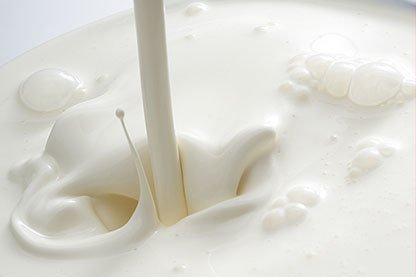
For a product to labelled as ‘cream’ it must have a minimum 30% fat content and about 6% non-fat ingredients (protein, lactose, minerals).
The rest is made up of water.
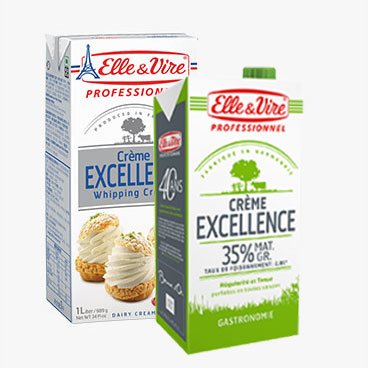

Since 1975 with the invention of one of the first UHT whipping cream, the Elle & Vire brand has become the benchmark in the professional world. Elle & Vire creams meet the needs of the most demanding Michelin-starred chefs (65% use Excellence cream). It is also the most exported French cream in the world.

A simple and natural ingredient, butter is made exclusively from milk cream.
22 litres of milk (2 litres of cream) are needed to make 1 kilo of butter. Butter can be enjoyed as part of a healthy, balanced diet. It is an important source of vitamin A which plays an essential role in growth. It is also a source of vitamin D.
The cream is separated from the milk.
The cream is beaten until fat globules agglomerate into little yellow grains and are thus separated from the buttermilk.
These grains are then rinsed with pure water and kneaded to ensure a smooth, even texture.
Elle & Vire’s butter-churning expertise lies in the combination of several key factors which are essential to making high-quality butter:
The quality of the cream :
It is made from fresh milk. You can’t make great butter without an excellent raw material! We even won 5 medals in a row in the Concours Général Agricole 2013!
Churning :
It is churned slowly and at a controlled temperature (less than 15°C) to enhance the taste of the butter.
Texturing :
The long texturing process and washing the grains of butter gives a smooth and even texture. The butter is worked in this way to develop its great taste.
Adding the ferments :
During texturing, the specific lactic ferments chosen by Elle & Vire’s master butter-churners, gives Elle & Vire’s churned butter a rich and refined flavour as well as a touch of acidity which helps prolong the life of the butter.
Packaging :
Our tear-resistant, complex aluminium packaging, like our light-blocking tubs, protect our butters from the light and therefore prevent it from developing a rancid and oxidised taste.
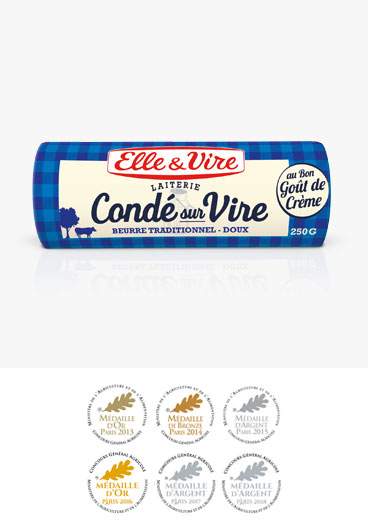
For a product to labelled as ‘butter’ it must have a minimum 82% fat content, maximum 16% water content and about 2% dry non-fat ingredients (protein, lactose, minerals).
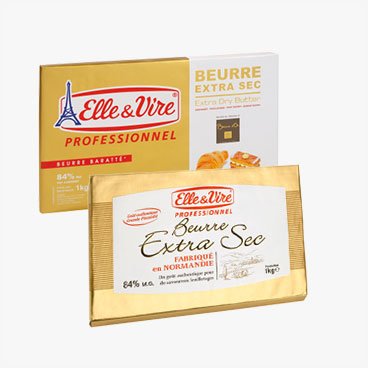

Butter is both a technical and tasty product. It plays an incomparable role in the fixation and balance of flavors while bringing friability, plasticity, fondant, mellowness according to the preparations. Extra-dry butter 84% fat is a technical butter of winter, more “dry” than a normal butter and whose extreme plasticity will allow to realize a perfect lamination alternating after 6 folds not less than 729 layers of butter and 730 thin layers of dough for a resulting offering crisp, melting and lightweight!

Over 70 years, Elle & Vire has developed real expertise in the production of dairy products. A pioneer in many technological fields, the brand has launched innovations that have revolutionised consumers' everyday lives, in particular in long life technologies:
Originally unpasteurised milk or unpasteurised liquid cream are very fragile products with a very short life: maximum 7 days refrigerated ... beyond that the products change.
And fresh milk or fresh cream, even having been flash pasteurised, cannot be kept more than 30 days at + 6°C. Difficult, after the war, to distribute throughout France and difficult for consumers to manage it...
This is why Elle & Vire became interested in sterilisation early on, offering milk in sterilised glass bottles in 1955: the milk was heated to 115°C for 20 minutes and then cooled.
This thermal treatment allows for conservation at room temperature but its long processing time (20 mins) leads to the development of a cooked taste and an ivory colouring.
Elle & Vire very quickly turned towards UHT sterilisation: heating for a few seconds at a temperature of 150°C, then quickly cooled and packaged in an aseptic packaging, the milk is preserved at room temperature and its nutritional and taste qualities are preserved. The products can be kept for 4 months at room temperature.

In 1960, Elle & Vire invented the first UHT sterilised milk, which could be kept for 8 weeks at the time : The 8S milk.
In 1975, Elle & Vire was one of the first brands to launch UHT milk in France, first for professionals, then very quickly for retail. This technological innovation will revolutionise the daily life of chefs and consumers.
Today, products can be kept for up to 4 months at room temperature without altering its nutritional qualities or taste.
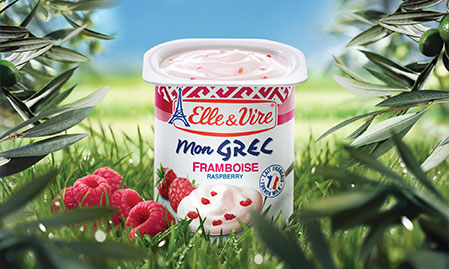
Elle & Vire has successfully developed its expertise in other dairy products and today offers a wide range of dairy desserts which are thermally treated yoghurts. Made in the same way as a traditional yoghurt, they are heated at high temperature after fermentation. This thermal treatment neutralises the bacteria found in milk and allows dairy desserts to be kept for longer (several months).
Our dairy desserts are heated at a slightly lower temperature than with UHT sterilisation. This means that the quality, safety, heath and practicality of the product can be guaranteed, while still retaining a deliciously fruity, creamy flavour.


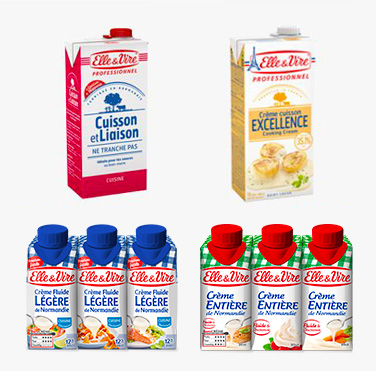

These go hand in hand with products treated at high temperature as they retain the product’s sterility for a long time.
Early on, Elle & Vire relied on long-term partnerships with some of its suppliers, such as Tetra Pak which manufactures milk or cream packaging or aseptic pot manufacturers.
Indeed, these packages are sterile and will protect the product, for several months even at room temperature, air and light to avoid organoleptic degradation and bacterial contamination.
Elle & Vire can, in this way, offer a little taste of France in more than 120 countries in the world. Aseptic packaging of milk, cream, and dairy or cream desserts allows
for a long shelf life which means our products can be transported by boat. This slow, but cost effective, transportation does not harm our competitiveness and guarantees an accessibility to certain populations.